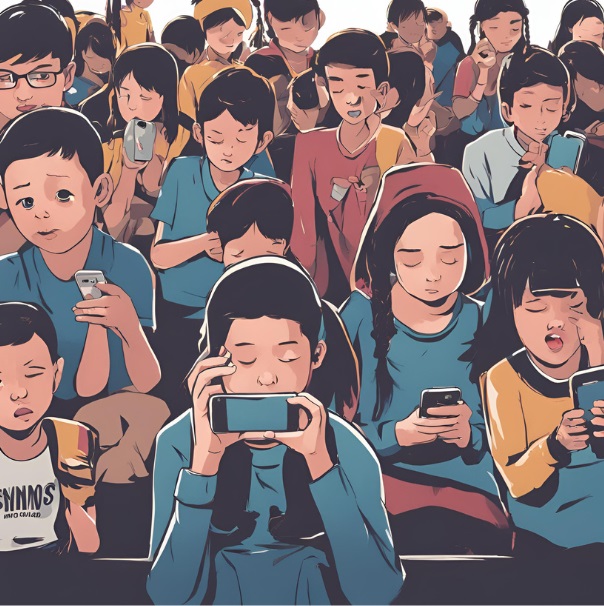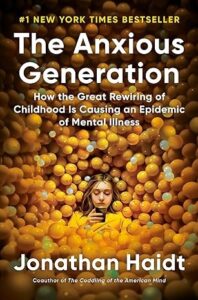- Books
- 7 de June de 2024
- No Comment
- 13 minutes read
Minors, Mobile Phones, and Mental Health: Correlation is Not Causality

Minors, Mobile Phones, and Mental Health: Correlation is Not Causality
The Anglo-Saxon press has rigorously covered both the highlights and shadows of Jonathan Haidt’s book, The Anxious Generation, which posits a straightforward relationship between the time minors spend on their mobile phones and their mental health issues


The release of Jonathan Haidt‘s much-anticipated book and the subsequent promotion have received significant coverage in Anglo-Saxon media. Perhaps one of the standout moments was the interview conducted by the legendary Pulitzer Prize-winning journalist David Remnick, biographer of Muhammad Ali among many other notable achievements, for The New Yorker on April 20th.
There is a generational complicity between the two, as Remnick is 65 and Haidt is 60. The conversation flows, and the text is a transcription of a radio interview. Haidt traces the origins of the issues he denounces—moving from overprotecting children in the real world to neglecting them in the virtual world—to the years between 2005 and 2010. This period saw the introduction of all the technological (smartphones, with the crucial incorporation of cameras) and digital innovations (the configuration of social networks as we know them today) that led to what he calls the “great rewiring” of young and adolescent brains, less prepared than adult brains to manage the universe of the possibilities of immediate distraction and access to infinite content at their fingertips.

Haidt’s thesis is attractive, logical, and intuitive. He warns of a large-scale change in “human consciousness“, in our way of seeing, interpreting, and narrating the world. The solutions he proposes are simple, though somewhat contradictory from my point of view, as I noted in the first entry of this series: the responsibility lies with large corporations, the passivity belongs to governments and legislators, but the obligation to act falls on the shoulders of families and educators. It is not all so simple, and many people have seen it this way.
In March, media outlets such as The Washington Post (WP), The New York Times (NYT), The Wall Street Journal (WSJ), and The Guardian (TG) reviewed Haidt’s book. Specialised publications like Wired, Politico, The Conversation, and The Atlantic also gave it attention. A brief summary may be useful to identify the main ideas that have been publicly discussed following the publication of The Anxious Generation.
The Guardian published an edited extract of the book on March 21st. Around the same time, Judith Warner, an expert in youth mental health and author of several impactful books, warned in a reliable collaboration for WP that Haidt’s proposal was “risky” because “proving causality (rather than mere correlation) is a dubious proposition”, particularly given the existence of “a large body of academic literature on the psychological harms of social media, which is ambiguous at best”. This line of argument is common in the media and academic critiques of Haidt’s book, well known to economists as correlation does not always imply causality.
Another point not to be overlooked was introduced by Haidt in an interview with Mark Novicoff for Politico: “an anxious, fearful, and threatened population will be more open to a strongman, an authoritarian leader, someone who promises to stop the chaos and end the threats”. This reveals that Haidt’s concern extends beyond the mental health of young people to the possible consequences this collective anxiety might have on public and democratic life. To everyone’s surprise, at the same time, he declared himself “tremendously optimistic” about Generation Z in the NYT—in line with his recent articles co-authored with Zack Rausch—considering them “aware of being in a trap. Therefore, they do not need to be pushed but rather offered a way out”, he argues.
In April, after the initial surge, some early criticisms began to surface, intensifying in May. Blake Montgomery in TG opened the floodgates to criticism on April 27th, accusing Haidt’s book of having a “biased anti-technology logic” and oversimplifying the problem of young people’s mental health by focusing solely on mobile devices. On May 10th, Steven Levy wrote in Wired that the book is a “jeremiad against social media” and that “digital connectivity is now part of childhood.” Hugh Breakey in The Conversation was more incisive, warning of the dangers of accepting intuitive arguments uncritically and noting the role of ideological biases into which Haidt may have fallen, whose previous bestseller already warned about the hyper-protectionism of the young and the weakening of their character due to the new concept of “safetyism,” which has led many parents to demand safe environments for their children and families at any cost, even at the price of censoring books, music, or films considered harmful to the young.
On May 6th, Ellen Barry dedicated a report in the NYT with the first academic criticisms of Haidt’s thesis. Citing various articles, Barry pointed out several lines worth considering: “the real problem is a grim social panorama of school shootings, poverty, and global warming. Or academic pressure. Or insufficient healthcare. A group of British researchers now proposes another explanation, at least partially: we talk too much about mental disorders. This hypothesis is called ‘prevalence inflation.’ It argues that our society has become so saturated with discussions about mental health that young people may interpret mild and fleeting suffering as symptoms of a medical disorder.” On May 9th, WP openly considered in an op-ed that it is complicated to affirm or sustain that smartphones are destroying childhood. A day later, the recognised technology and family expert of the WSJ, Julie Jargon, not only questioned the causality Haidt establishes without much evidence but also put on the table the often-forgotten gender perspective: a chapter of the book is exclusively dedicated to girls, whom Haidt presents as more prone to depression because boys manage it by isolating themselves with their video games or watching pornography alone.
The final stretch of media critiques was led by a prestigious academic, cited by many journalists, who wrote an extensive article for The Atlantic on May 21st. Candice Odgers provided an overview of the most recent scientific literature—incapable of affirming with Haidt’s certainty that there is a direct correlation between the time spent connected to a screen and mental disorders—and highlighted some risks arising from the proliferation of alarmist headlines: it is not good to spread panic about the use of mobile phones by young people; fear will only deprive researchers of the tools to continue investigating the complex relationship between minors and mobiles, social networks, and video games, and so many other things in the digital world; and most importantly, it is the real, offline life that truly influences young people’s mental health and their exposure to violent or inappropriate online content.
In conclusion, Haidt’s book cannot be denied its sense of opportunity, though it is necessary to read it in context and understand the academic critiques it has received. It is also worth asking what ideal model of education and training for young people Haidt proposes. All of this, of course, without losing sight of Candice Odgers’ mention of the decisive influence of offline life on young people’s mental health. As an example, Craig Sewall, a researcher specialising in the relationship between technology and mental health, provides a sobering statistic: in the last two decades, nearly 1.2 million young Americans have lost a parent due to drugs or shootings and firearm incidents. The average is sixty thousand each year. Given these data, it would be strange if nothing affected them. Perhaps the devices they use so much are more of a refuge—a symptom—than a danger—a cause. This reflection will be left for the third and final instalment on The Anxious Generation.
See the first entry of this series
Source: educational EVIDENCE
Rights: Creative Commons

